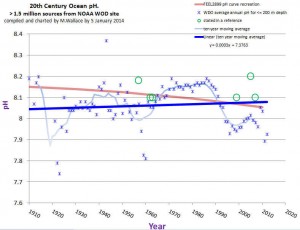
Ocean pH Time Series
Here is a global ocean pH time series chart that includes tabulation of the 1,567,902 pH values for the ‘pelagic’ zone, taken from the WOD database. To approximate the pelagic zone, I limited data extractions to those samples from sea depths less than or equal to 200m.
I have also uploaded a zip file containing associated WOD snail trail maps of the global ocean sample sites for each individual year to a public dropbox folder. The zip file is nearly 55mb and can be downloaded for free at:
https://dl.dropboxusercontent.com/u/100449329/Ocean_pH_measurementLocationsAllYears.zip
The green circles are from previous published estimates and those references are included in my earlier ocean pH meta data post, where they were depicted as open red circles.
The red line is the Feel2899 curve. The Feel2899 authors labeled this curve as “Historical”, although that turned out not to be the case as they have confirmed directly to me through email communications.
The light blue solid line is the 10 year moving average of the individual annual mean values (the blue x’s). A moving average is essential because for many individual years the coverage of pH across the globe is spotty. The year 1943 is a good but extreme example of this. Also for some years early in the history of ocean pH measurement, there were no ocean pH measurements recorded (especially around WWI).
The dark blue line is a linear fit to the 10 year moving average. This line is the best linear estimator that I have been able to develop of any secular trend in global ocean pH, based solely on measurement records.
It’s possible that much or all of this post-1988 data was not recorded using glass electrode pH meters. As my earlier posts document, the ocean science community has moved away from glass electrodes starting about 1989, although other parts of the water scientific community and other industries continue to use glass electrode pH meters for all ranges of ionic strengths.
copyrights 1966 to 2014 MW&A all rights reserved.
 5820total visits,4visits today
5820total visits,4visits today


